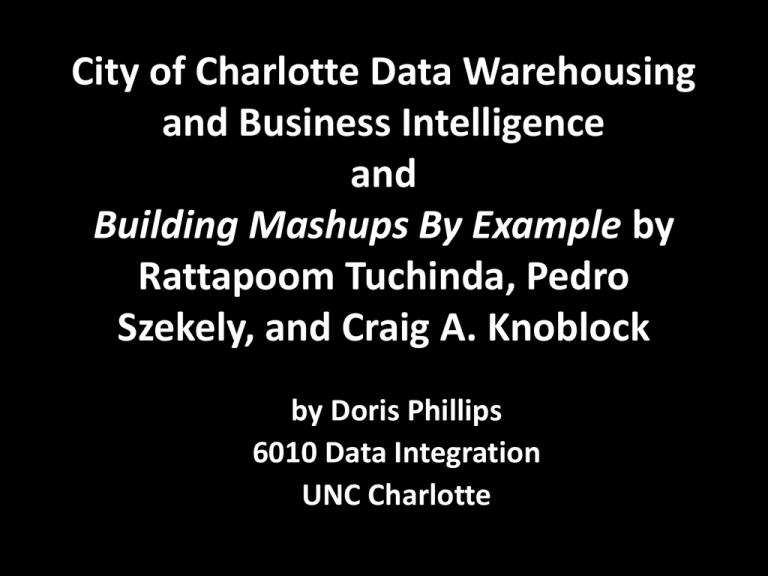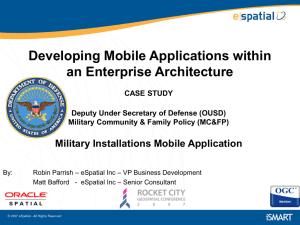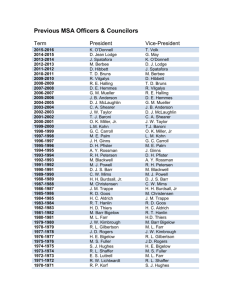Building Mashups By Example Rattapoom Tuchinda, Pedro Szekely
advertisement

City of Charlotte Data Warehousing and Business Intelligence and Building Mashups By Example by Rattapoom Tuchinda, Pedro Szekely, and Craig A. Knoblock by Doris Phillips 6010 Data Integration UNC Charlotte Business Decision Making My KBU ORG’s Which? (Raper, J., Building a Data Warehouse in a Heterogeneous Tool Environment) Overview • Describe current data warehousing/business intelligence methods at the City of Charlotte • Present Building Mashups By Example by Rattapoom Tuchinda, Pedro Szekely, and Craig A. Knoblock • Compare data warehousing techniques to data integration methods for mashups 3 Focus on Processes Common to Data Warehousing and Data Integration • • • • Data Retrieval Data Modeling Data Cleaning Data Integration Common processes but not the same! 4 Data Warehousing at the City of Charlotte 5 DISCLAIMER The views and opinions presented in this paper are solely those of the Author and do not necessarily reflect those of Business Support Services Information Technology Division or of the City of Charlotte. This material is provided for informational purposes only. City of Charlotte assumes no responsibility for accuracy of the information in this paper or from damages caused by implemented the techniques or methodologies presented herein. City of Charlotte Simplified KBU Organization Chart Mayor and City Council City Manager Offices and Commissions Utilities Budget Roads, Streets, Bridges, Intersections Neighborhood Development Bus and Rail Fire Airport Police Human Resources Business Support Services Finance Solid Waste Engineering and Property Management (Raper, J., Building a Data Warehouse in a Heterogeneous Tool Environment) Sample Data Sources • • • • • • Accounts Payable Accounts Receivable Asset Center Emerald Faster General Ledger • • • • • • Kronos Hansen PeopleSoft Remedy Unisys Helpdesk Utility Billing System HUB and Spoke Design SOURCES TARGET DATA MARTS DB2 DB FIN MS/SS MART ETL MS/ SS DB ORA DATA VAULT ODS DV DTS SWS MS/SS MART OWB DB Oracle OWB UTL ORA MART FILES (Raper, J., Building a Data Warehouse in a Heterogeneous Tool Environment) Data Vault Components • • • • • Hubs - Key Topics Links – Relationships Satellites – Details Auxiliaries – Support Implemented as Relational Tables • Diagramed Using Distinctive Shapes HUB_XXXX Hub Record Shape LNK_XXXX Link Record Shape Satellite Record Shape SAT_XXXX_YYYYYY AUX_XXXX Auxiliary Record Shape (Raper, J., Phillips, D., User-Managed Metadata: Oracle Application Express Meets Oracle Warehouse Builder 10.2) 10 Hub Tables • Hub records contain the logical business and physical keys to the business data and its context. • Relatively Stable over Time • Keys – Primary Key – Surrogate ID – Natural Key – Unique Logical Key Fields (Raper, J., Phillips, D., User-Managed Metadata: Oracle Application Express Meets 11 Oracle Warehouse Builder 10.2) Link Tables • Link records provide information related to relationships between Hubs and Links. • The information in link records can and does change over time. • May have one or more Satellite Type records • Keys – Primary Key – Surrogate ID – Natural Key – Unique Logical Key Fields – Foreign Key – HUB or LNK SIDs (Raper, J., Phillips, D., User-Managed Metadata: Oracle Application Express Meets 12 Oracle Warehouse Builder 10.2) Satellite Tables • Satellite records provide the structure to hold the context or descriptive type information from operational systems. • Maintain these changes over time. • Related Directly to Hub or Link Records • Keys – Primary Key – Surrogate ID – Foreign Key – HUB or LNK SIDs (Raper, J., Phillips, D., User-Managed Metadata: Oracle Application Express Meets 13 Oracle Warehouse Builder 10.2) Auxiliary Tables • Auxiliary records contain a variety of cross reference and lookup descriptions tied to logical business keys. • Standalone Support Tables Not Directly Linked to HUB, SAT, or LNK tables. • Types of Auxiliaries – Lookups – Cross References – External Tables – ETL Work Tables • Keys – Primary Key is NK – Unique Logical Key Fields – May have FK (Raper, J., Phillips, D., User-Managed Metadata: Oracle Application Express Meets 14 Oracle Warehouse Builder 10.2) Generic Data Vault Schema SAT SAT SAT SAT LNK HUB HUB SAT SAT AUX SAT AUX AUX (Raper, J., Phillips, D., User-Managed Metadata: Oracle Application Express Meets 15 Oracle Warehouse Builder 10.2) Oracle Warehouse Builder Mapping New Code Capture (Raper, J., Phillips, D., User-Managed Metadata…) 16 Oracle Warehouse Builder Mapping New Code Capture Detail (Raper, J., Phillips, D., User-Managed Metadata…) 17 Data Cleaning • • • • • Convert to UPPER case Trim blank spaces Replace NULL within UNK or UNKNOWN Check for valid values using lookups Remove duplicates 18 Metadata Capture - Cross Reference Organization Codes APEX Application (Raper, J., Phillips, D., User-Managed Metadata…) 19 Data Warehouse Approach • Extracted data from multiple heterogeneous sources • Converted to Data Vault Architecture • Cleaned data and transformed into desired format • Combined data from multiple sources • Data provided to users for reporting and data visualizations 20 Building Mashups By Example by Rattapoom Tuchinda, Pedro Szekely, and Craig A. Knoblock 21 Overview • Mashup: A web application that integrates data from multiple web sources to provide a unique service • Goal: Create a mashup building framework where an average Internet user with no programming experience can build Mashups easily 22 Current Solutions • Widget Paradigm – Current Solutions involve selecting, customizing, and connecting widgets together • Disadvantages – As number of widgets gets large, locating the right widget becomes confusing and time consuming – Connecting widgets required understanding programming concepts 23 Widgets – Yahoo Pipes (Tuchinda, et. al, p. 140) 24 Microsoft Popfly United States Information Widget - EDIT United States Information Widget - RUN 25 Mashup Building Process • Data Retrieval – Extracting data from web pages into a structured source (table or XML) • Source Modeling – Process of assigning the attribute name for each data column • Data Cleaning – Required to fix misspellings and transform extracted data into the appropriate format • Data Integration – Specifies how to combine two or more data sources together 26 Karma Solution “The left window is an embedded web browser. The top right window contains a table that a user would interact with. The lower right window shows options that the user can select to get into different modes of operation.” (Tuchinda, et. al, p. 140) 27 Data Retrieval – Karma Table User Selects Value from Page, List Automatically Populated (Tuchinda, et. al, p. 140-141) User Selects Address for Value, List Automatically Populated 28 Source Modeling - Attributes Karma Attributes • Karma compares extracted data with existing data in its repository • Automatically populates some attributes • User specifying the correct attribute • Users search existing attributes in data repository Example 29 Data Cleaning • Users specify what data to clean • Karma tries to pick up desired transformations and populate the remaining columns 30 Data Integration Karma • Analyzes attributes and data to determine possible join conditions • Suggests existing data sources in the repository that can be linked to the new data in the table 31 Data Integration Karma Problems • Locating the related sources from the repository • Figuring out the query to combine the new source and existing valid sources 32 Data Integration Karma Solution • Uses table constraints • Uses programming methods and procedures induced from user interaction 33 Mashup Building Approach • Combines most problem areas in Mashup building into a unified interactive framework that requires no widgets • Allows users with no programming background to easily create Mashups by example 34 Conclusions Data Warehouse • Data from enterprise applications and maintained sources • Historical data for trending and analysis • Extract, Transform, and Load • Often Strategic information Data Integration / Mashup • Data from web that may not be maintained or may contain errors • Real time data for current information • Extract, Model, and Clean • Often tactical information 35 Resources • Linstedt, D. http://www.danlinstedt.com/AboutDV.php. Nov. 9, 2008. • Linstedt, D., Garziano, K., Hultgren, H., May 2008. The New Business Supermodel: The Business of Data Vault Modeling. • Raper, Jim., Dec. 2004. Building a Data Warehouse in a Heterogeneous Tool Environment. • Raper, Jim., Dec. 2004. From Source to Loading Dock with Oracle Warehouse Builder • Raper, Jim., Phillips, Doris., 2006. User-Managed Metadata: Oracle Application Express Meets Oracle Warehouse Builder 10.2 • Tuchinda, R., Szekely, Pl., Knoblock, C., 2008. ACM., Building Mashups by Example. 36







